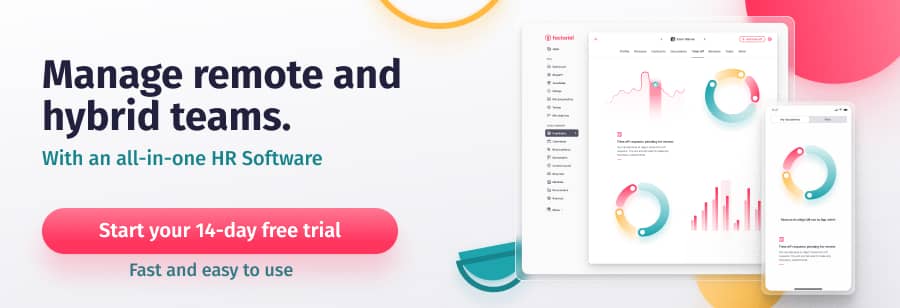Throughout the Covid pandemic, many companies were forced to adjust to remote working models. Now that the world has begun to return to normality, many companies are opting to maintain a hybrid work schedule. This offers a balance of remote and office-based work and it’s proving to be a successful model for many companies. It is also an option that benefits many employees.
In fact, according to a recent report by USA Today, nearly 50% of workers would be willing to take a pay cut for remote working options. There are a few things to consider, however, including the logistical challenges they can present to people teams.
In this post, we will take a look at the hybrid work model and the benefits it offers. We will also discuss the various hybrid work models being used and which tools will help you implement and coordinate a model that works best for you. 
What is a hybrid work schedule?
A hybrid work schedule is a working model that enables employees to combine working in the office with working from home. This model is becoming increasingly popular as Covid lockdowns ease because companies are realizing that there is no need to return to a 100% office-based environment. This provides employees with a level of flexibility that hasn’t been seen before.
The rapid shift to remote work when the first Covid wave hit was a shock to the system for most people. A new army of remote workers was forced to adjust to a new way of working. Although this model offered many benefits, such as a lack of commute and a better work-life balance, it also led to an increase in employee burnout and issues with communication.
A hybrid work schedule could be the solution that finds the right balance between the two working models. You get the benefits of working from home, but you also get to touch base with your colleagues on a regular basis. A win-win solution.
Benefits of a hybrid work schedule
- A hybrid work schedule offers the right balance of convenience and productivity. For one thing, your employees spend less time commuting. They also spend less time distracted by the usual comings and goings of a crowded office. Instead, their time can be used more efficiently, allowing them to be more productive but also giving them the convenience of being able to attend to non-work tasks when needed. The flexibility of a hybrid work model also benefits employees with caregiving and other outside-of-work responsibilities as they can adapt their schedule around other duties. The same goes for employees with chronic physical or mental health issues who may sometimes struggle to be productive in a traditional setting, resulting in reduced absence rates.
- The autonomy that a hybrid solution offers results in increased job satisfaction. This is because employees feel valued and that their health and well-being is important. It also results in less burnout, increased engagement, and improved communication compared to exclusively remote working models.
- A hybrid work model increases employee engagement and output. Less stress, reduced time commuting to and from the office, working where and when they like, freeing up more time for exercise. These are the ingredients that pump up productivity and keep burnout at bay.
- The future of work is agile. The companies that set themselves up for long-term workplace flexibility today will be in a stronger position than those that don’t. Regardless of diseases, the organizational agility that comes with hybrid work schedules is key to any organization’s success.
- The final obvious benefit is cost savings. Flexible working means fewer employees are at the office at one time, resulting in savings on office space and utilities.
Determining the right hybrid work model
If you decide to implement a flexible schedule at your company, then you need to determine which hybrid work model works best for you.
Generally speaking, there are 4 models currently being used by companies around the world:
The at-will model
This model provides the most flexibility, as employees can choose the work arrangement that works best for them on any given day. They can come into the office whenever they have a meeting or just decide they would like a break from home. This gives them the flexibility to work remotely when it suits them better. This model has its obvious downsides, though, as you never know how many people will be in the office at any given time.
The split-week model
This model splits the week between working from home and working from the office. Employees have designated days each week when they come into the office. This means that everyone knows who will be in on which day. This hybrid work schedule enables managers to stay in touch with their teams on a fixed regular basis.
The shift work model
This model works best in companies where employees work shifts. Half the team come into work for the morning shift, and half the team comes in for the afternoon shift. The rest of the time, employees work from home. This model has a few downsides. The most notable is that employees have to either start work very early or finish very late. This can make it difficult for employees to juggle childcare arrangements.
The week-by-week model
Finally, the fourth model is where employees alternate between working from home and working onsite on a weekly basis. You can use this model if you have large teams that need to use your office space together at the same time and meet up for reviews, deadlines, and updates.
Implementing a hybrid work schedule
You have to take many things into consideration if you decide to implement a sustainable hybrid work schedule in your company. Firstly, you need to think about autonomy, collaboration, and productivity so that there is a sense of inclusivity between team members. Secondly, you need to make sure employees are performing to the best of their ability and they have the right tools and resources to fulfil their duties remotely.
Communication is also a key factor. You need to establish how teams and individuals will communicate to ensure seamless operations between on-site and off-site workers. Make sure your employees are up to date with all new policies and procedures. You could even share a few tips for working remotely and optimizing their home office to help them adjust to their new schedules.
Here are a few other questions you will need to ask yourself:
- Will your employees have the freedom to choose when they come into the office, or will there be fixed schedules?
- Is there going to be a set schedule for working hours?
- How will you manage team meetings and other departmental activities?
- Will you offer a dedicated workspace for each employee, or will you implement a “hot desking” policy?
- What about stipends for home office supplies or utilities?
- Which tools will you use to measure performance and output?
- How will you make sure employees working from home have access to the same tools and remote software as those working from the office?
- Do you need to offer training to your managers so that they are ready to manage a hybrid workforce?
- Which platforms will you use to ensure all teams stay connected, both to each other and to other departments?
Hybrid work models and office space
Aside from scheduling difficulties, hybrid work models can pose problems when it comes to things like available office space and desks. Many hybrid teams choose to implement “hot desking” and employee workspace is available on a first come, first serve basis.
Although hot desking solves some of the problems that come with hybrid work models, it does not account for everything. Particularly, it can be difficult to ensure a comfortable working environment for everyone when there is limited space available. Under these circumstances, it actually runs the risk of discouraging employees from coming into the office.
The best way to make sure hybrid work works for everyone is to use a desk reservation system like the one offered by Desky. Desky is a new Factorial application that allows you to design an office map and book workspaces. Not only does this solve the logistical problems that come with hybrid office space, but it allows you to promote productivity and gain visibility into your team’s hybrid working schedule.
How to coordinate flexible and hybrid work schedules
One final important thing you need to consider when you implement your hybrid work schedule is how you are going to manage and coordinate it. Are you going to use specific tools and technology to manage shifts?
One option is to use an employee schedule template to keep things organized. However, this is a basic tool that’s open to confusion and human error. This means it’s not a great solution in the long term.
Another option is to invest in shift scheduler software. This makes it easy to plan recurring shifts on a regular basis, visualize schedules, and run custom reports. You can use tools to assign and alter employee shifts, run reports to see trends and visualize important data. And your employees can easily check up on their upcoming shifts and request changes through an employee portal. All this makes for a much more efficient hybrid work model.
If you are looking for a shift management solution, Factorial may be just what you are looking for. Our shift management software is included with a subscription to Factorial’s comprehensive HR software. Our all-in-one HR solution offers other telecommuting software features too, such as communication platforms and document managers.
You can use the software to:
- Organize and manage your employees’ work schedules
- Plan employee shift scheduling weekly or over a longer duration
- Receive notifications of newly published or modified staff shifts
- Create schedules for employee shifts in the employee shift schedule app
- Filter employees and shifts by teams
- Filter by location and office
Sign up now to try Factorial’s shift scheduler for free.


